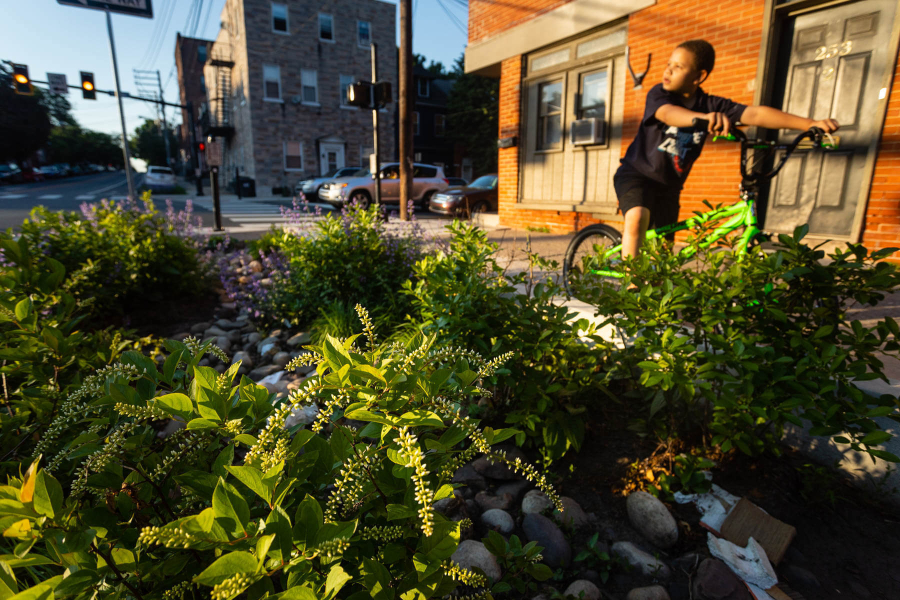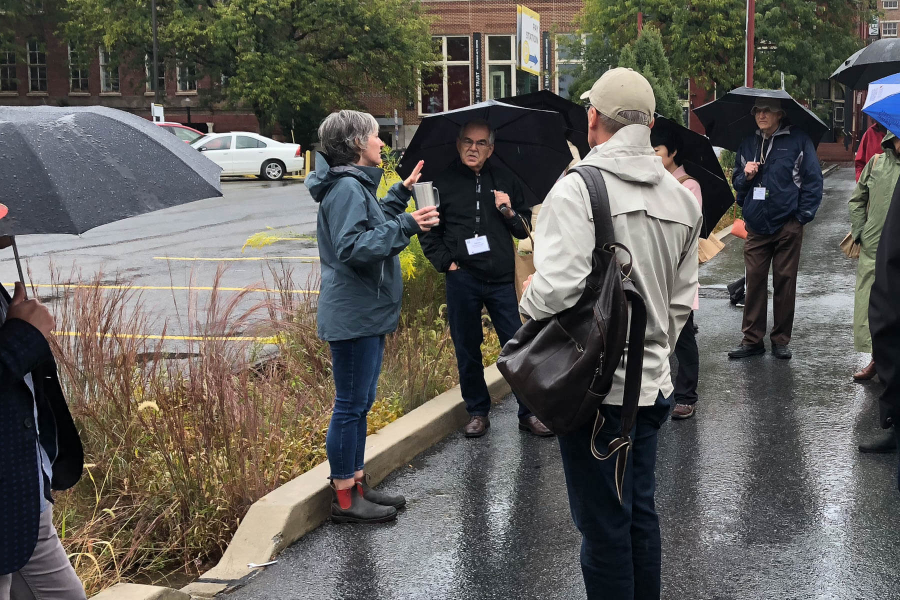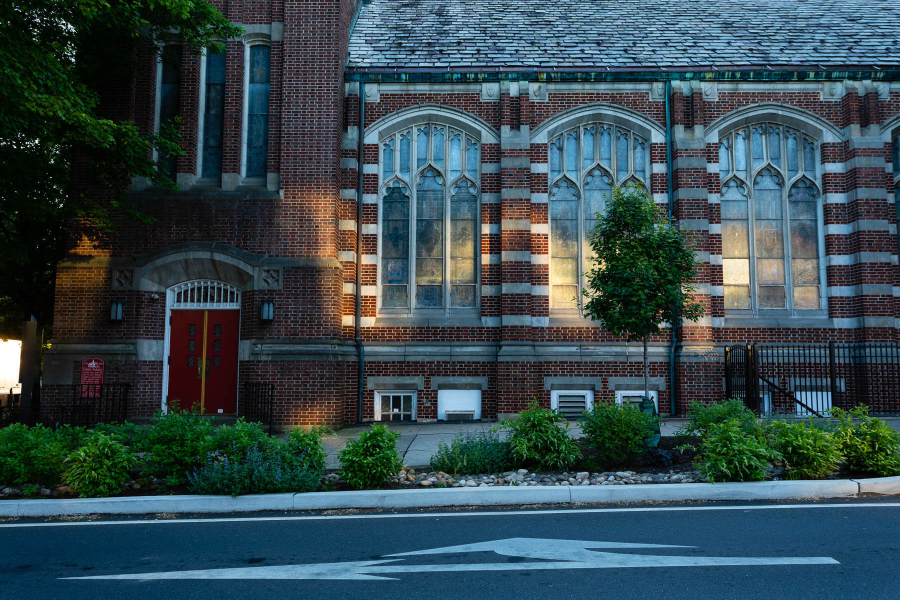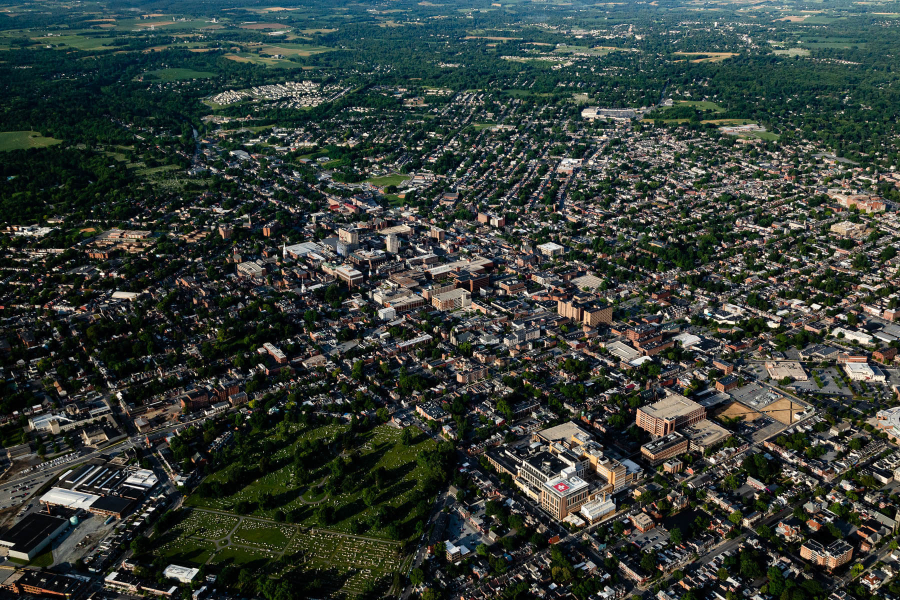Touring the latest green infrastructure projects in Lancaster Pennsylvania
Local planners visit nine projects in Lancaster

How do you improve water quality in a dense, urban setting while also making it more livable for everyone? One rainy Sunday in early October, 22 city and regional planners from across Pennsylvania learned just how during a tour of green infrastructure projects in Lancaster.
The Chesapeake Bay Program’s Local Government Advisory Committee sponsored the walking tour, alongside the Pennsylvania Chapter of the American Planning Association, in an effort to show local planners how the city controls stormwater runoff with green infrastructure. Led by Kathryn Austin, green infrastructure coordinator for the City of Lancaster, and Douglas Smith, chief planner, Department of Community Planning and Economic Development, the walking tour included nine stops highlighting various green infrastructure projects that are key to the city’s stormwater plan.
Lancaster is the county seat, with a population of 58,503 (according to the 2020 Census). It’s in the heart of Pennsylvania Dutch Country surrounded by productive agriculture lands. Population is on the rise in Lancaster, with many people moving to the area to retire. The downtown is especially picturesque, with many buildings dating back to the 1700’s. Lancaster is situated in the Conestoga watershed, which drains to the Susquehanna River.

Green It! Lancaster is the 25-year plan for improving water quality in the Conestoga River. Like so many municipalities throughout the Bay watershed, Lancaster has a Combined Sewer System, which means rainwater runoff, domestic sewage and industrial wastewater are all collected and treated through the same pipes. The city must comply with stormwater permits to reduce the amount of nutrients and sediment in the watershed.
Plans to achieve better stormwater management have two components: grey infrastructure, which are often engineered solutions such as upgrades to wastewater treatment plants; and green infrastructure, which replicates and restores the natural hydrologic cycle while reducing the volume of water that goes into the sewer system. The vision of the city’s Green Infrastructure Plan is to provide more livable, sustainable neighborhoods for city residents and to reduce combined sewer overflows and nutrients. To fully institutionalize green infrastructure into Lancaster’s urban landscape, the Green Infrastructure Plan proposes a combination of policy actions, incentives for property owners and innovative funding approaches to support ongoing implementation costs.
Stops on the tour included:
- Lancaster’s famous Central Market, which features porous paver parking spaces and a rain garden.
- The Mulberry Arts Studio, which has a subsurface infiltration bed beneath a parking lot.
- Mulberry Street, complete street; a two-way conversion project with curbside rain gardens and porous paver parking areas.
- The Community Mennonite Church of Lancaster, a private green parking lot conversion with porous pavement, native plantings and rain gardens.
- Charlotte Street, complete street; another two-way conversion project with curbside rain gardens and porous paver parking areas.
- Prince and Walnut streets, curbside rain gardens.
- Walnut and Queen streets, a subsurface soil cell system for street tree plantings.
- Walnut and Duke streets, curbside rain gardens with a bike lane.
- Lancaster Brewing Company, realigned intersection, curbside rain gardens, porous paver parking and seating areas, porous asphalt alley and a cistern.


The tour proved that green infrastructure can be integrated into public spaces to achieve multiple ends, including pedestrian safety, economic development and native habitat. It is a proven investment in both clean water and thriving urban communities. Lancaster is a great example of implementing green infrastructure at scale, and across municipal programs. Planners who participated in the tour were impressed particularly with the "green streets” Lancaster has implemented—a means of retrofitting busy urban streets with vegetation and permeable pavers that soak up runoff better than asphalt or concrete.
In Lancaster, planners learned how important it is to understand the geography and history of a site’s location. The aptly named Water Street in Lancaster sits at the bottom of a slope in the location of a former streambed, which impacted the type of infrastructure planners could use. On Walnut and Queen streets, trees weren’t draining properly and had to be replaced to species that fit the site better.
Funding of the overall program and the individual projects can also be challenging. For Lancaster, funds are provided by a stormwater fee. Also, maintenance of green streets takes a slightly different set of skills than regular street maintenance. City of Lancaster staff are trained to maintain the structures in good working condition.
Scott Duncanson, a senior environmental planner with Gannett Fleming from Camp Hill, Pennsylvania, captured the sentiments of the planners, “This was an awesome mobile workshop! Kate Austin and Doug Smith did a great job showcasing a variety of green infrastructure projects within the City of Lancaster. While it did rain for most of the workshop, it allowed the participants to see the green infrastructure in action.”
Lancaster will continue to implement their Green Infrastructure Plan to add economic and aesthetic value to this historic downtown in the Chesapeake Bay watershed.

Comments
There are no comments.
Thank you!
Your comment has been received. Before it can be published, the comment will be reviewed by our team to ensure it adheres with our rules of engagement.
Back to recent stories